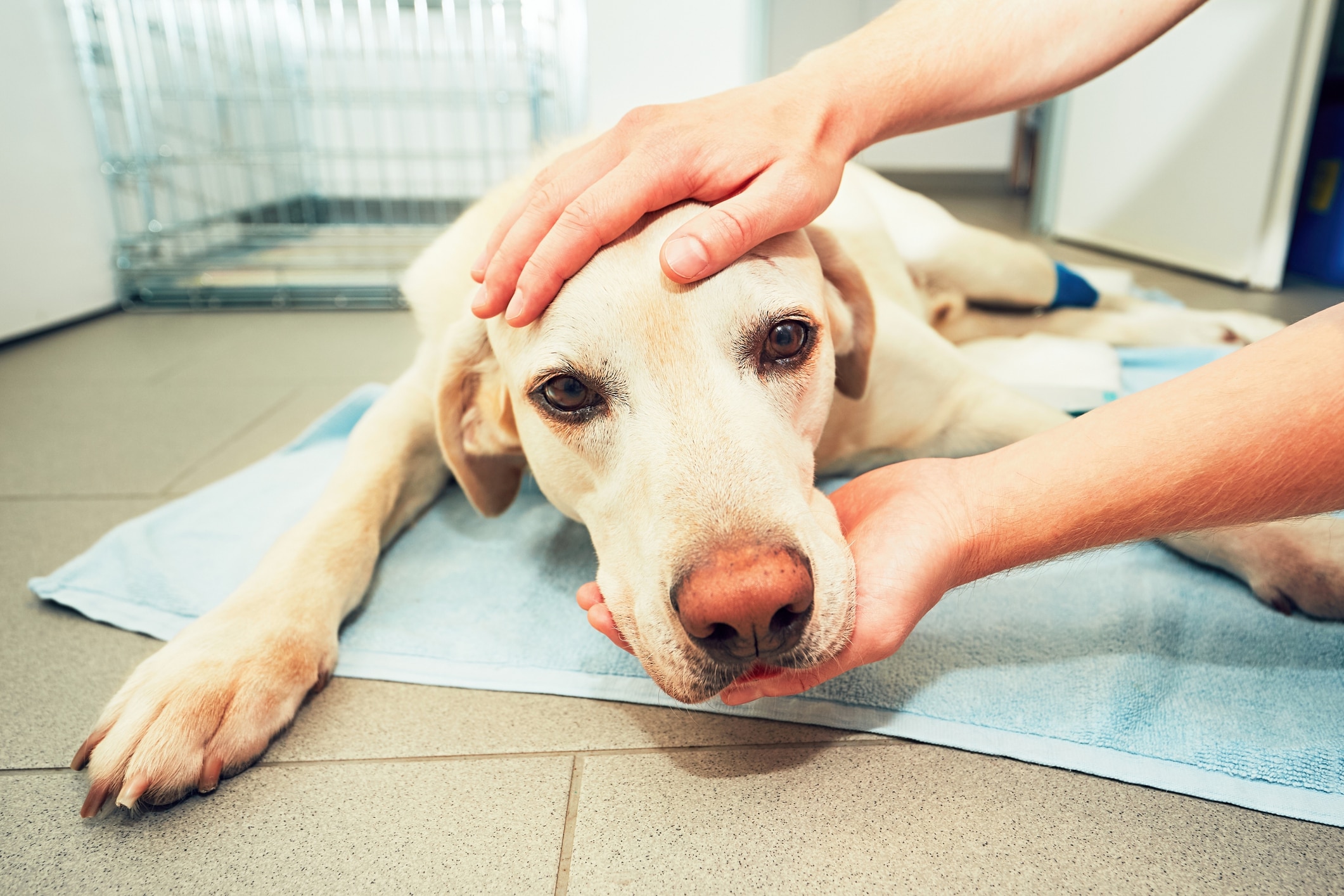Your furry best friend just doesn’t get around like they used to — and your usual, “C’mon Buddy,” isn’t helping in the least. If you’re noticing your pet has decreased mobility or signs of pain, it’s possible they could be facing an arthritis diagnosis. If so, what does the future mean?
According to the Banfield Pet Hospital 2019 Veterinary Emerging Topics (VET) Report, 41% of cats and 51% of dogs newly diagnosed with osteoarthritis, the most common form of arthritis, are overweight. So the top tip is: Helping your pet maintain a healthy weight could put you both on a better path.
We asked Dr. Emi Saito, of Banfield Pet Hospital, all about arthritis in pets, including things you can do to help prevent it. Read on for symptoms, how arthritis is diagnosed and more ways to help keep your pet healthy.
What are the most common forms of arthritis seen in cats and dogs?
There are three forms of arthritis that are most commonly seen in pets: osteoarthritis, septic arthritis and immune-mediated arthritis, Saito says.
1. Osteoarthritis (OA)
This is the most common form seen in pets and is due to damage to the joint tissue.
“The primary cause of osteoarthritis is unknown, but the condition can be the result of a variety of causes, including trauma, genetics or other conditions that lead to abnormal wear of the joint,” Saito says. “This can include joint dislocation, torn knee ligament, hip dysplasia and luxating patella.”
All of these causes can spell pain and could explain your pet’s inability to do things like they used to.
2. Septic arthritis
This type of arthritis is caused by a bacterial or fungal infection of the joint, Saito says. Inflammation will cause pain in the joint.
3. Immune-mediated arthritis
This is due to the pet’s own immune system invading the joints and causing joint inflammation, Saito says, and for some pets, the underlying cause of this can be unknown.
What are signs that your pet may have arthritis?
A few common signs seen across the three different forms are:
- Lameness.
- Decreased mobility.
- Swollen joint(s).
- Loss of muscle mass.
The signs you’ll see will depend on the form of arthritis that is affecting your pet, Saito says, so it’s important to partner with your veterinarian who can evaluate his or her symptoms.
“In some cases, pets may gradually develop signs of osteoarthritis, and owners may mistakenly attribute these to be normal signs of their pet getting older,” she says, adding that other of signs of osteoarthritis may include:
- Decreased interest in play or in activity levels.
- Moving slower or reluctance to go on walks.
- Reluctance or inability to go down steps.
- Sensitivity to touch or reluctance to being touched or groomed.
- Growling or aggressive behavior.
Felines may show different signs.
“Cats have a few signs of arthritis that can be unique to them: urinating outside of the litter box; difficulty getting on and off perches in one jump like they used to; and hair mats or dandruff because they are unable to thoroughly groom themselves,” Saito says.
Signs of septic arthritis can include:
- Fever.
- Lethargy.
- Loss of appetite.
- Affected joint being swollen and/or warm to the touch.
Signs of immune-mediated arthritis may include:
- Fever.
- Loss of appetite.
- Weight loss.
- Lethargy.
In some cases, affected pets may show little or no noticeable signs of joint-related issues.
How is arthritis diagnosed?
Your veterinarian will be your best resource throughout the process of figuring out what’s plaguing your pet.
“If you notice lameness or any changes in behavior in your pet, make an appointment to have your pet examined by a veterinarian,” Saito says. “Only your veterinarian can determine through a thorough physical examination, and possibly some radiographs or other tests, whether the signs you are noticing are due to arthritis.”
Waiting could mean more discomfort for your friend, so it’s best to act when you first see signs.
“The earlier that arthritis is diagnosed, the sooner treatment can begin to improve your pet’s comfort,” Saito says. “For osteoarthritis, while there is no cure and the joint degeneration will continue over the life of your pet, there are treatment options that may help slow that degeneration and improve joint health.”
What are the most common treatment options available?
If your pet is diagnosed with osteoarthritis, your vet will focus on managing pain.
“Your veterinarian might recommend anti-inflammatory and/or pain medications,” Saito says. “Joint supplements are also available that may support your pet’s joint health.”
If your pet is overweight, managing those extra pounds will help his or her condition.
“Weight management is very important for pets with osteoarthritis, as excess weight can contribute to the joint degeneration,” Saito says. “So, if your pet has even a few extra pounds, your veterinarian can help you develop a weight loss plan for your pet.”
Exercising can be an important factor also to help your pet maintain mobility.
“This can include daily play sessions, walks or physical therapy sessions,” she says.
In certain cases, Saito says surgery may be recommended by your veterinarian to manage a related underlying condition, like hip dysplasia or a torn knee ligament, for example.
For septic arthritis, your veterinarian might recommend antibiotics or medication to treat the infection, she notes, and immune-mediated arthritis treatment will depend on the type or cause but can include anti-inflammatory or chemotherapy drugs.
What’s the prognosis for cats or dogs who suffer from arthritis?
You may be sad that life with your pet could change due to arthritis, and that’s a natural reaction, but there are ways to combat the pain and help your pet stay mobile, so talk with your veterinarian about all the options.
“Once diagnosed, while prognosis depends on location and severity of the joint disease, your pet will likely require treatment in some form for the rest of their life, with the goal of providing them with comfort and mobility,” Saito says of osteoarthritis.
The prognosis can vary with septic arthritis, she adds, and it ranges from recovery to development of osteoarthritis, to recurring or spreading of infection. Some pets will recover completely from immune-mediated arthritis and others may have relapses.
Can you prevent arthritis?
“Although canine arthritis isn’t entirely preventable, there are various habits pet owners can develop earlier rather than later to help delay onset,” Saito says. First and foremost, regular vet visits “including twice-yearly comprehensive examinations, are recommended to ensure early detection, diagnosis and treatment planning for any signs of arthritis or conditions that could lead to arthritis.”
Other ways to help prevent arthritis are:
1. Find out if your pet is at risk and make changes.
Some pets may be more prone to developing arthritis than others.
“Talk to your veterinarian about whether your pet may be at higher risk of developing certain conditions, such as neck or spinal conditions, and what preventive measures you can take, for example using harness restraints instead of collars,” she says.
2. Learn how to recognize pain.
If you have a happy-go-lucky pet, pain may be hard to spot, so get smart.
“Talk to your veterinarian before you notice signs about ways to recognize pain or discomfort in your pet in the early stages,” Saito says. “Your pet may exhibit subtle signs or behaviors at the onset of a condition like arthritis, and by the time signs like limping are noticed, there may already be irreversible joint damage.”
3. Keep your pet active.
Nobody (you and your fur-kid included) should be lounging around 24/7.
“Not only does [exercise] help maintain a healthy weight, but healthy muscle mass supports your pet’s joints and can support the weight load the joints carry when your pet is moving and jumping around,” Saito says.
4. Ask your vet about supplements for your dog.
“Numerous joint supplements are available, but not all are created equal, nor do they all contain the same ingredients,” Saito says. “Talk to your veterinarian about the best supplement options for your dog based on their unique needs and medical history, while keeping in mind that some dogs may do better on multiple supplements. Key ingredients to look for may include but are not limited to glucosamine, chondroitin, omega 3 fatty acids (EPA and DHA), phycocyanin and manganese.”





